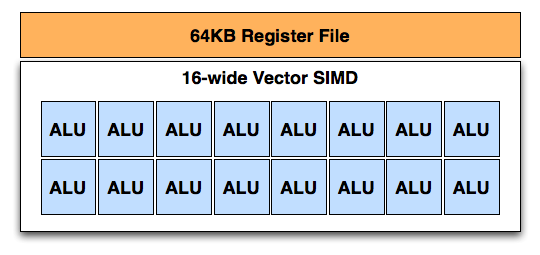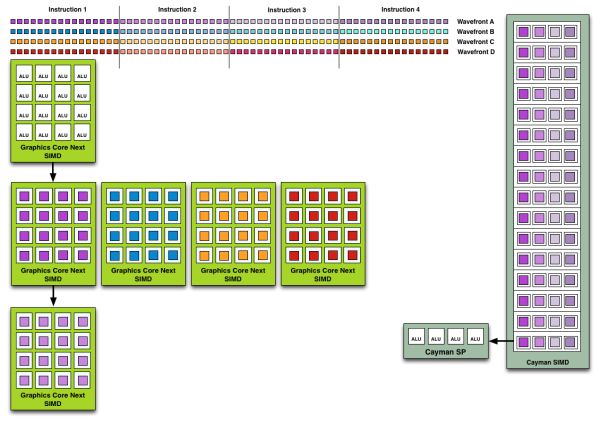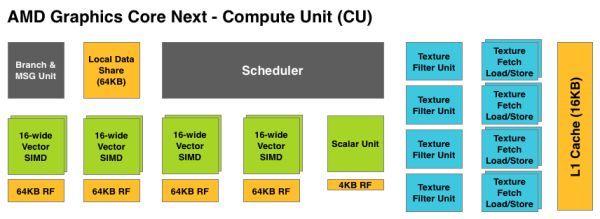AMD Radeon HD 7970 Review: 28nm And Graphics Core Next, Together As One
by Ryan Smith on December 22, 2011 12:00 AM EST- Posted in
- GPUs
- AMD
- Radeon
- ATI
- Radeon HD 7000
A Quick Refresher, Cont
Having established what’s bad about VLIW as a compute architecture, let’s discuss what makes a good compute architecture. The most fundamental aspect of compute is that developers want stable and predictable performance, something that VLIW didn’t lend itself to because it was dependency limited. Architectures that can’t work around dependencies will see their performance vary due to those dependencies. Consequently, if you want an architecture with stable performance that’s going to be good for compute workloads then you want an architecture that isn’t impacted by dependencies.
Ultimately dependencies and ILP go hand-in-hand. If you can extract ILP from a workload, then your architecture is by definition bursty. An architecture that can’t extract ILP may not be able to achieve the same level of peak performance, but it will not burst and hence it will be more consistent. This is the guiding principle behind NVIDIA’s Fermi architecture; GF100/GF110 have no ability to extract ILP, and developers love it for that reason.
So with those design goals in mind, let’s talk GCN.
VLIW is a traditional and well proven design for parallel processing. But it is not the only traditional and well proven design for parallel processing. For GCN AMD will be replacing VLIW with what’s fundamentally a Single Instruction Multiple Data (SIMD) vector architecture (note: technically VLIW is a subset of SIMD, but for the purposes of this refresher we’re considering them to be different).

A Single GCN SIMD
At the most fundamental level AMD is still using simple ALUs, just like Cayman before it. In GCN these ALUs are organized into a single SIMD unit, the smallest unit of work for GCN. A SIMD is composed of 16 of these ALUs, along with a 64KB register file for the SIMDs to keep data in.
Above the individual SIMD we have a Compute Unit, the smallest fully independent functional unit. A CU is composed of 4 SIMD units, a hardware scheduler, a branch unit, L1 cache, a local date share, 4 texture units (each with 4 texture fetch load/store units), and a special scalar unit. The scalar unit is responsible for all of the arithmetic operations the simple ALUs can’t do or won’t do efficiently, such as conditional statements (if/then) and transcendental operations.
Because the smallest unit of work is the SIMD and a CU has 4 SIMDs, a CU works on 4 different wavefronts at once. As wavefronts are still 64 operations wide, each cycle a SIMD will complete ¼ of the operations on their respective wavefront, and after 4 cycles the current instruction for the active wavefront is completed.
Cayman by comparison would attempt to execute multiple instructions from the same wavefront in parallel, rather than executing a single instruction from multiple wavefronts. This is where Cayman got bursty – if the instructions were in any way dependent, Cayman would have to let some of its ALUs go idle. GCN on the other hand does not face this issue, because each SIMD handles single instructions from different wavefronts they are in no way attempting to take advantage of ILP, and their performance will be very consistent.

Wavefront Execution Example: SIMD vs. VLIW. Not To Scale - Wavefront Size 16
There are other aspects of GCN that influence its performance – the scalar unit plays a huge part – but in comparison to Cayman, this is the single biggest difference. By not taking advantage of ILP, but instead taking advantage of Thread Level Parallism (TLP) in the form of executing more wavefronts at once, GCN will be able to deliver high compute performance and to do so consistently.
Bringing this all together, to make a complete GPU a number of these GCN CUs will be combined with the rest of the parts we’re accustomed to seeing on a GPU. A frontend is responsible for feeding the GPU, as it contains both the command processors (ACEs) responsible for feeding the CUs and the geometry engines responsible for geometry setup. Meanwhile coming after the CUs will be the ROPs that handle the actual render operations, the L2 cache, the memory controllers, and the various fixed function controllers such as the display controllers, PCIe bus controllers, Universal Video Decoder, and Video Codec Engine.
At the end of the day if AMD has done their homework GCN should significantly improve compute performance relative to VLIW4 while gaming performance should be just as good. Gaming shader operations will execute across the CUs in a much different manner than they did across VLIW, but they should do so at a similar speed. And for games that use compute shaders, they should directly benefit from the compute improvements. It’s by building out a GPU in this manner that AMD can make an architecture that’s significantly better at compute without sacrificing gaming performance, and this is why the resulting GCN architecture is balanced for both compute and graphics.












292 Comments
View All Comments
SlyNine - Friday, December 23, 2011 - link
Are you nuts, the 5870 was nearly 2x as fast in DX 10/9 stuff, not to mention DX11 was way ahead of DX10. Sure the 6970 isn't a great upgrade from a 5870, but neither is the 7970.Questionable Premise
CeriseCogburn - Thursday, March 8, 2012 - link
That happened at the end of 2006 with the G80 Roald. That means AMD and their ATI Radeon aquisition crew are five years plus late to the party.FIVE YEARS LATE.
It's nice to know that what Nvidia did years ago and recently as well is now supported by more people as amd copycats the true leader.
Good deal.
Hauk - Thursday, December 22, 2011 - link
A stunningly comprehensive analysis of this new architecture. This is what sets Anandtech apart from its competition. Kudos Ryan, this is one of your best..eastyy - Thursday, December 22, 2011 - link
its funny though when it comes to new hardware you read these complicated technical jargon and lots of detailed specs about how cards do things different how much more technically complicated and in the end for me all it means is...+15fps and thats about itas soon as a card comes out for say 150 and the games i play become slow and jerky on my 460 then i will upgrade
Mockingbird - Thursday, December 22, 2011 - link
I'd like to see some benchmarks on FX-8150 based system (990fx)piroroadkill - Friday, December 23, 2011 - link
Haha, the irony is that AMD is putting out graphics cards that would be bottlenecked HARDCORE by ANY of their CPUs, overclocked as much as you like.It's kind of tragic...
Pantsu - Friday, December 23, 2011 - link
The performance increase was as expected, at least for me, certainly not for all those who thought this would double performance. Considering AMD had a 389mm^2 chip with Cayman, they weren't going to double the transistor count again. That would've meant the next gen after this would be Nvidia class huge ass chip. So 64% more transistors on a 365mm^2 chip. Looks like transistor density increase took a bit of a hit on 28nm, perhaps because of 384-bit bus? Still I think AMD is doing better than Nvidia when it comes to density.As far as the chip size is concerned, the performance is OK, but I really question whether 32 ROPs is enough on this design. Fermi has 48 ROPs and about a billion transistors less. I think AMD is losing AA performance due to such a skimpy ROP count.
Overall the card is good regardless, but the pricing is indeed steep. I'm sure people will buy it nonetheless, but as a 365mm^2 chip with 3GB GDDR5 I feel like it should be 100$ cheaper than what it is now. I blame lack of competition. It's Nvidia's time to drop the prices. GTX 580 is simply not worth that much compared to what 6950/560Ti are going for these days. And in turn that should drop 7970/50 price.
nadavvadan - Friday, December 23, 2011 - link
Am I really tired, or is:" 3.79TFLOPs, while its FP64 performance is ¼ that at 947MFLOPs"
supposed to be:
" 3.79TFLOPs, while its FP64 performance is ¼ that at 947-G-FLOPs"?
Enjoyed the review as always.
Death666Angel - Friday, December 23, 2011 - link
Now that you have changed the benchmark, would it be possible to publish a .pdf with the relevant settings of each game? I would be very interested to replicate some of the tests with my home system to better compare some results. If it is not too much work that is (and others are interested in this as well). :Dmarc1000 - Friday, December 23, 2011 - link
What about juniper? Could it make it's way to the 7000 series as a 7670 card? Of course, upgraded to GCN, but with same specs as current cards. I guess that at 28nm it would be possible to abandon the pci-e power requirement, making it the go-to card for oem's and low power/noise systems.I would not buy it because I own one now, but I'm looking forward to 7770 or 7870 and their nvidia equivalent. It looks like next year will be a great time to upgrade for who is in the middle cards market.